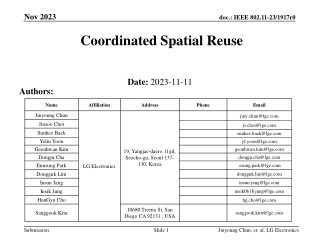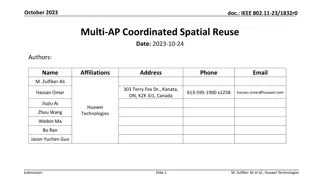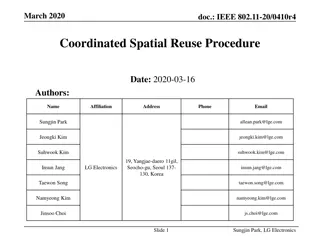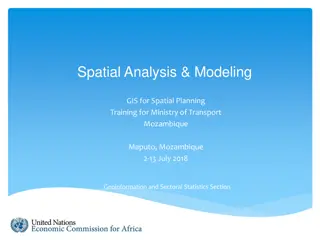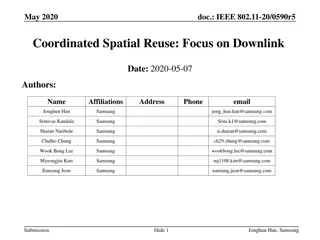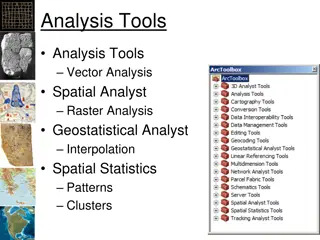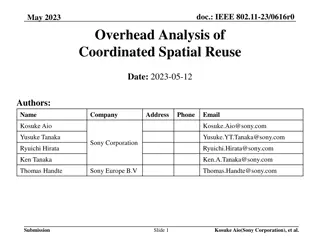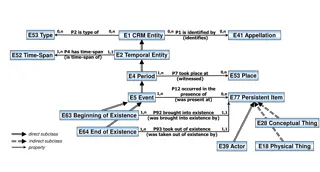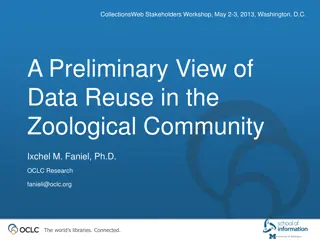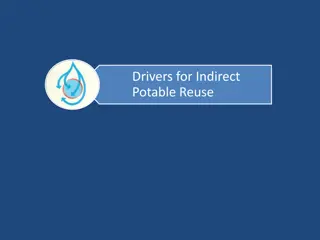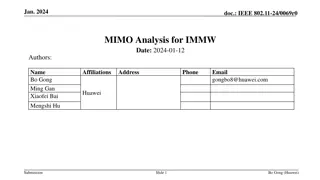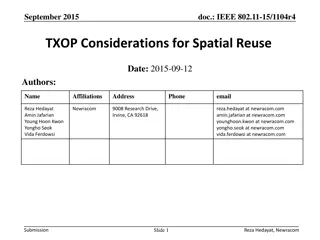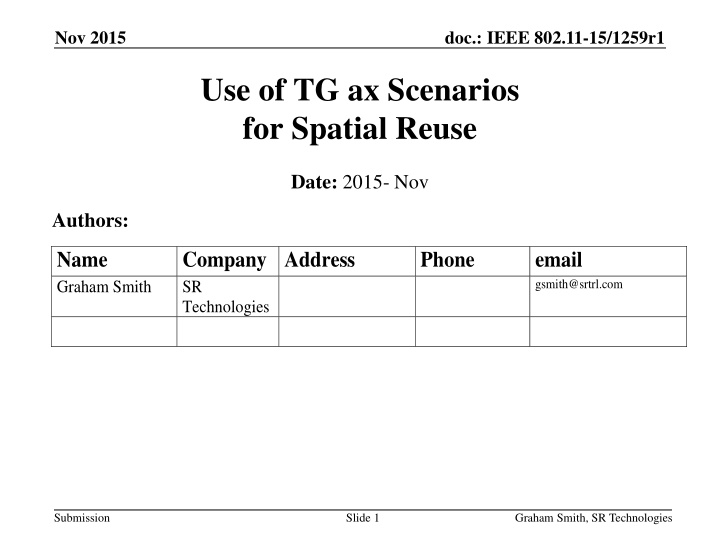
Utilizing TG.ax Scenarios for Improved Spatial Reuse in IEEE 802.11 Networks
Enhance spatial reuse evaluations in IEEE 802.11 networks by adjusting scenarios to simulate technologies improving spatial reuse, such as channel allocations and throughput assessments. Explore the impact of various channel allocations on total throughput across different areas, focusing on factors like area size, available channels, and random versus intelligent selection in network configurations.
Download Presentation

Please find below an Image/Link to download the presentation.
The content on the website is provided AS IS for your information and personal use only. It may not be sold, licensed, or shared on other websites without obtaining consent from the author. If you encounter any issues during the download, it is possible that the publisher has removed the file from their server.
You are allowed to download the files provided on this website for personal or commercial use, subject to the condition that they are used lawfully. All files are the property of their respective owners.
The content on the website is provided AS IS for your information and personal use only. It may not be sold, licensed, or shared on other websites without obtaining consent from the author.
E N D
Presentation Transcript
Nov 2015 doc.: IEEE 802.11-15/1259r1 Use of TG ax Scenarios for Spatial Reuse Date: 2015- Nov Authors: Name Graham Smith Company Address SR Technologies Phone email gsmith@srtrl.com Submission Slide 1 Graham Smith, SR Technologies
Nov 2015 doc.: IEEE 802.11-15/1259r1 Background Present scenario details do not include channel allocations that allow spatial re-use technologies to be fully evaluated The channel allocations are fixed in the simulation scenarios Spatial reuse technologies are tending to be assessed using the existing scenarios This presentation proposes how to adjust the scenarios such that technologies that attempt to improve spatial reuse can be better simulated and evaluated DSC, Color, TPC, etc Does not propose any changes to the Simulation Documents, BUT proposes (common) scenario conditions such that spatial reuse can be assessed. Submission Slide 2 Graham Smith, SR Technologies
Nov 2015 doc.: IEEE 802.11-15/1259r1 Channel Re-use A basic aim of the Spatial Reuse sub TG is basically to increase the channel reuse across an area and hence increase the total throughput of that area. Hence, some of the factors that are important are: The area size The more possibility of channel reuse The number of available channels Allocated in managed networks Random selection or intelligent selection in unmanaged networks 20, 40MHz, 80MHz. Adaption and sharing Submission Slide 3 Graham Smith, SR Technologies
Nov 2015 doc.: IEEE 802.11-15/1259r1 Channel Allocations 5GHz 5170 MHz 5330 MHz 5490 MHz 5710 MHz 5735 MHz 5835 MHz 104 108 120 136 140 149 153 157 161 165 100 124 128 132 144 112 116 IEEE channel # 20 MHz 40 MHz 80 MHz 36 40 44 48 52 64 56 60 160 MHz Ref:Wikipedia USA 21 10 4 1 Eu Japan 19 23 9 10 4 5 2 2 China 13 6 3 1 Korea 21 10 5 2 25 20MHz Channels 12 40MHz Channels 6 80MHz Channels 2 160MHz Channels Spatial re-use schemes can take advantage of the use of multiple channels. Submission Slide 4 Graham Smith, SR Technologies
Nov 2015 doc.: IEEE 802.11-15/1259r1 Proposed Methodology for SR Take existing Simulation Scenario THEN Vary the channel allocations 20, 40, 80MHz channels Apply each SR technology See effect on throughputs, etc. compared to legacy Submission Slide 5 Graham Smith, SR Technologies
Nov 2015 doc.: IEEE 802.11-15/1259r1 Apartment Sharing 14/0328r2 # Apartments Channel BW with Channels selection - DSC # Apartments Channel BW with Channel Selection Channels 20 19 13 10 9 6 3 40MHz 20MHz 100 100 100 Channels 20 19 13 10 9 6 3 40MHz 20MHz 100 100 96 32 45 58 1 2 x 20MHz 3 x 20MHz 4 x 20MHz 5 x 20MHz 6 x 20MHz 7x20MHz 8x20MHz 4 100 100 100 82 68 53 10 0 2 32 0 18 6 56 10 12 7 8 # Apartments Channel BW with Random Channels selection - DSC # Apartments Channel BW with Random Channels selection Channels 20 19 13 10 9 6 3 40MHz 20MHz 65 63 43 35 34 22 0 2 x 20MHz 25 27 32 32 34 42 0 3 x 20MHz 4 x 20MHz 5 x 20MHz 6 x 20MHz 7x20MHz 8x20MHz 9x20MHz 10 10 22 3 3 9 24 4 3 4 10 Channels 20 19 13 10 9 6 3 40MHz 20MHz 2 x 20MHz3 x 20MHz 96 4 96 4 93 4 8 3 10 3 20 6 32 21 3 30 23 8 0 89 87 74 35 18 14 24 27 8 Unmanaged scenario Intelligent or random allocation of channels makes huge difference Using DSC predicts no OBSS with 6-10 channels and intelligent selection - is this true? Submission Slide 6 Graham Smith, SR Technologies
Nov 2015 doc.: IEEE 802.11-15/1259r1 Proposed SR variations for Residential Scenario Operating channels: Proposed Scenarios for SR A - 5GHz: random assignment of channels Random selection of primary channel per operating channel 4 80MHz channels (6), 9, 10 40 MHz non-overlapping channels, B - 5GHz: Intelligent assignment of channels Intelligent selection entails looking for free channel then only if no free channel available, select one already in use. 4 80MHz channels (6), 9, 10 40 MHz non-overlapping channels, NOTE: Alternative is to fix the allocations (intelligently) thus allowing less variation in simulations Submission Slide 7 Graham Smith, SR Technologies
Nov 2015 doc.: IEEE 802.11-15/1259r1 Possible fixed channel allocations 6 Ch 4 Ch 4 2 4 2 4 4 2 4 2 4 1 3 1 3 1 2 4 2 4 2 3 1 3 1 3 1 3 1 3 1 2 4 2 4 2 3 1 3 1 3 4 2 4 2 4 1 1 3 1 3 1 6 3 5 2 4 4 1 6 3 5 5 2 4 1 6 6 3 5 2 4 4 1 6 3 5 5 2 4 1 6 6 3 5 2 4 4 1 6 3 5 5 2 4 1 6 6 3 5 2 4 5 1 3 1 3 1 2 4 2 4 2 3 1 3 1 3 4 2 4 2 4 1 3 1 3 1 2 4 2 4 2 3 1 3 1 3 4 2 4 2 4 1 3 1 3 1 2 4 2 4 2 1 4 3 6 2 2 5 1 4 3 3 6 2 5 1 1 4 3 6 2 2 5 1 4 3 3 6 2 5 1 1 4 3 6 2 2 5 1 4 3 3 6 2 5 1 1 4 3 6 2 8 4 9 3 9 5 10 1 6 5 7 6 2 7 1 8 7 3 8 2 9 8 4 9 3 9 5 10 1 6 5 7 6 2 7 1 8 7 3 8 2 9 6 7 5 9 4 4 8 6 7 5 5 9 4 8 6 6 7 5 9 4 4 8 6 7 5 5 9 4 8 6 6 7 5 9 4 4 8 6 7 5 5 9 4 8 6 6 7 5 9 4 10 4 6 10 4 6 10 10 1 6 4 8 1 2 7 5 9 2 3 8 1 4 9 2 6 4 5 10 3 7 5 1 6 4 8 1 2 7 5 9 2 3 8 1 4 9 2 6 4 5 1 4 3 6 2 2 5 1 4 3 3 6 2 5 1 1 4 3 6 2 2 5 1 4 3 3 6 2 5 1 1 4 3 6 2 2 5 1 4 3 3 6 2 5 1 1 4 3 6 2 10 3 7 5 10 3 10 3 10 Ch 9 Ch Submission Slide 8 Graham Smith, SR Technologies
Nov 2015 doc.: IEEE 802.11-15/1259r1 Enterprise Scenario Present scenario Four 80MHz channels 1 2 1 2 1 2 1 2 Legacy total OBSS 4-6 overlaps DSC Approx 30% STA overlap No AP overlap 3 4 3 4 3 4 3 4 1 2 1 2 1 2 1 2 3 4 3 4 3 4 3 4 Alternative Nine 40MHz channels Legacy All STAs & APs overlap DSC No overlap 1 2 3 1 2 3 1 2 4 5 6 4 5 6 4 5 7 8 9 7 8 9 7 8 How does Throughput compare With 4 x 80 channels 1 2 3 1 2 3 1 2 Submission Slide 9 Graham Smith, SR Technologies
Nov 2015 doc.: IEEE 802.11-15/1259r1 Enterprise Scenario Enterprise Scenario Channel allocation 5GHz: A - Four 80 MHz channels (Ch1, Ch2, Ch3, Ch4) The channel distribution can be: Ch1: BSS 4k-3 Ch2: BSS 4k-2 Ch3: BSS 4k-1 Ch4: BSS 4k k=1~8, is the office index. B - Nine 40MHz channels arranged across the 8 Offices as shown below: 1 2 3 1 2 3 1 2 4 5 6 4 5 6 4 5 7 8 9 7 8 9 7 8 1 2 3 1 2 3 1 2 Submission Slide 10 Graham Smith, SR Technologies
Nov 2015 doc.: IEEE 802.11-15/1259r1 Indoor Small Scenario Channel reuse 7. Add Reuse 7 and wall loss. 4 6 3 6 7 5 With 10m cell radius and a topology of 180m across, the assumption of no obstruction losses is not realistic. (people, walls, desks, furniture, etc.) 7 1 5 2 5 4 3 2 1 2 3 6 4 4 7 6 3 5 7 6 5 1 7 2 5 4 1 1 3 4 2 2 6 4 7 3 It is proposed that a simple wall loss for each cell wall should be added 3 7 6 5 6 7 5 1 2 2 4 5 1 3 2 4 3 6 7 Layout of BSSs channel allocations in case of 7 channel reuse. Submission Slide 11 Graham Smith, SR Technologies
Nov 2015 doc.: IEEE 802.11-15/1259r1 Indoor Small Scenario reuse 7 STAs are placed randomly (uniform distribution) within the 61 cell area that covers the reuse 7 pattern. STA identifies which (of the 61) APs from which it receives the highest power (based on distance-based pathloss and shadowing). If the corresponding AP does not yet have N1 STAs associated to it, then STA associates to it; else STA is removed from the simulation. This process is repeated until each of the co-channel APs has exactly N1 STAs associated to it. Channel Model PL(d) = 40.05 + 20*log10(fc/2.4) + 20*log10(min(d,10)) + (d>10) * 35*log10(d/10) + 7*W Note: could use 3*W in place of 7 d = max(3D-distance [m], 1) fc = frequency [GHz] W = number of cell walls traversed Primary Channels 5GHz: 40 MHz BSS Per each 40MHz use same primary channel across BSSs Submission Slide 12 Graham Smith, SR Technologies
Nov 2015 doc.: IEEE 802.11-15/1259r1 Outdoor Large BSS scenario Outdoor Large BSS Scenario Center Frequency, BW and primary channels Similar to indoor scenario 5GHz [Same Primary channel] BSSs use 40MHz channels with reuse 7 Submission Slide 13 Graham Smith, SR Technologies
Nov 2015 doc.: IEEE 802.11-15/1259r1 Summary There are 21 x 20MHz, 10 x 80MHz and 4 x 80 MHz channels in the USA for example, let s use them! The purpose of the Spatial reuse technologies is to allow better use of available channels over the areas of interest. If using 10 x 40MHz channels with SR technology provides better throughput than 10 x 40MHz channels legacy, or indeed 4 x 80MHz channels, then that is what we need to know The basis for 11ax is to get a throughput increase across an area The present Simulations Scenarios have fixed channel allocations BUT SR needs to evaluate SR use! Hence, let s see what happens when we apply SR techniques let the channels vary! get closer to reality maybe we will see the magic 4 x improvement Submission Slide 14 Graham Smith, SR Technologies
Nov 2015 doc.: IEEE 802.11-15/1259r1 Straw Poll Do you agree that when evaluating Spatial Reuse technologies the channel allocations should be allowed to be varied along the lines indicated in this document, rather than only use the fixed assignments as specified in the Simulation Document? Y/N/A Submission Slide 15 Graham Smith, SR Technologies

